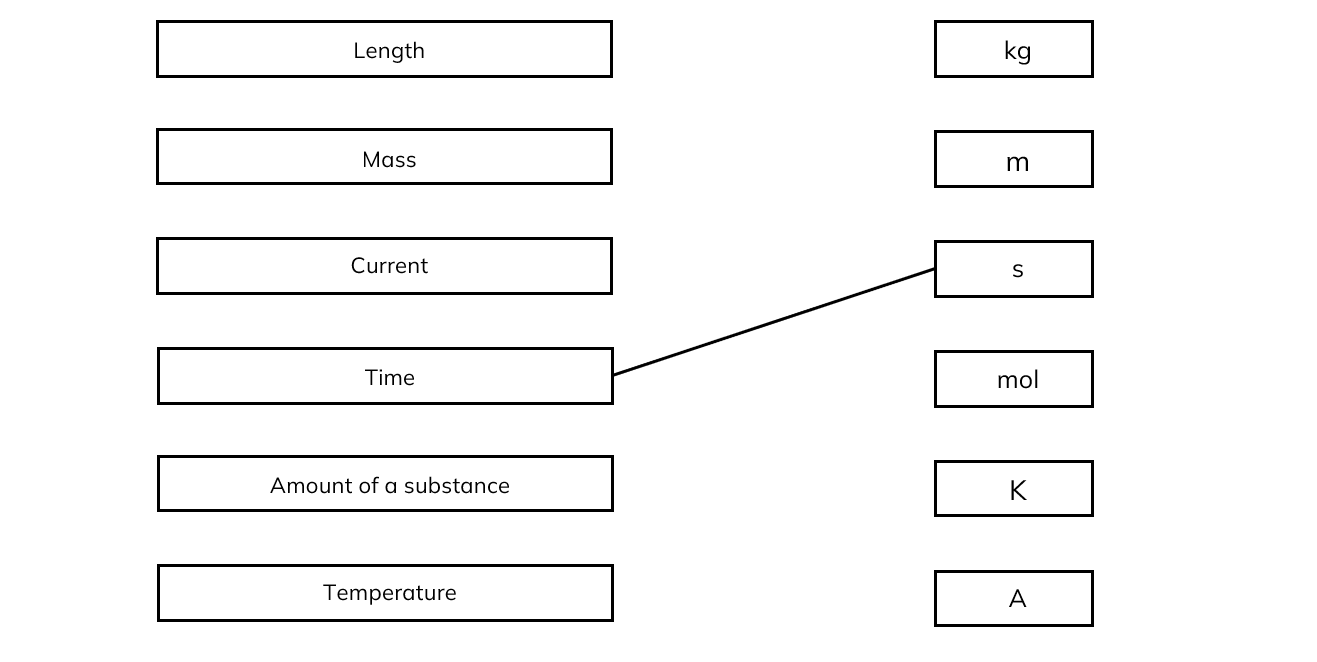(a)
Match the correct quantity to the SI base unit
[3]
Newton's second law of motion describes the relationship between force, F, mass, m, and acceleration, a.
F = ma
The derived unit for force is the newton (N).
(b)
Using Newton's second law, determine the SI base units of force
[2]
The kinetic energy equation describes the relationship between energy E, mass, m, and velocity, v.
E =  mv 2
mv 2
The derived unit for energy is the joule (J).
(c)
Using the kinetic energy equation, determine the SI base units for energy
[2]
The derived unit for power, P, is the watt (W).
(d)
Given that power is the energy transferred, E, per unit time, t, deduce the SI base units for power
[2]
(a)
Outline the reason why scientists use scientific notation
[1]
(b)
Express the following numbers in scientific notation
(c)
Express the following numbers in scientific notation
(d)
Express the following numbers in their original form
(a)
Complete the table by adding in the missing names of the unit prefixes and their corresponding metric multiplier:
|
Unit Prefix
|
Multiplier
|
|
tera
|
|
| |
109
|
|
|
103
|
|
centi
|
10−2
|
|
milli
|
|
|
micro
|
|
|
|
10−9
|
|
pico
|
10−12
|
[3]
(b)
Convert the following measurements into SI units using scientific notation
(c)
State the number of significant figures in the following measurements
(d)
State the measurement 103 660 pg to
(i)
4 significant figures
[1]
(ii)
2 significant figures
[1]
(iii)
1 significant figure
[1]
The distance from Earth to the edge of the observable universe is approximately 4.40 × 1026 m.
(a)
State the order of magnitude for this distance
[1]
(b)
State the order of magnitude that is:
(i)
100 times larger than 5.5 × 102
[1]
(ii)
1 000 000 times smaller than 9.1 × 104
[1]
(iii)
1000 times larger than 3 × 10−20
[1]
(c)
Match the description to the correct order of magnitude
[3]
The radius of the Earth is approximately 6.4 × 106 m.
(d)
Using an approximation for the typical arm span of a person, estimate the number of people it would take to circle the Earth holding hands.
(a)
Convert 1 year into seconds. Give your answer to 2 significant figures in scientific notation.
[3]
The wave equation describes the relationship between wave speed, c, frequency, f, and wavelength, λ.
c = fλ
UV rays travel at the speed of light and have a frequency of 900 × 1012 Hz.
(b)
Calculate the wavelength of the UV ray in nm.
[3]
UV rays travel from the Sun to the Earth in 500 ms.
(c)
State the relevant SI base unit for time and convert the given value to its SI base unit.
[2]
A light-year is the distance that light travels in a year.
(d)
Calculate the value of 1 light-year in km. You may use your answer from part (a) in your calculation.
[4]
mv 2

